

Migrant birds lose breeding grounds to poor farm management. Theconversation. Each year, humans reduce the number of trees worldwide by 15 billion.
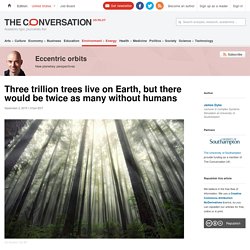
This is one of the startling conclusions of new research published in the journal Nature. The study also estimates the Earth is home to more than three trillion trees – that’s 3,000 billion – so you may think that while 15 billion is a very large number, humans shouldn’t be at risk of making significant changes to global tree cover. However, the team of 31 international scientists led by Thomas Crowther at Yale University also present evidence that the rise of human civilisation has reduced the numbers of trees on Earth by 46%. La humanidad ya ha destruido la mitad de todos los árboles del planeta. Es el tipo de pregunta que deja sin guardia a cualquier padre y que ni las mejores mentes han podido responder de forma satisfactoria: ¿Cuántos árboles hay en el mundo?
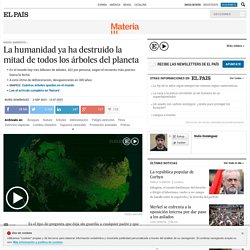
Un nuevo estudio acaba de aportar el cálculo más preciso hasta el momento y los resultados son sorprendentes, para lo bueno y para lo malo. Hasta ahora se pensaba que hay 400.000 millones de árboles en todo el planeta, o 61 por persona. Theconversation. By the end of the century, the world’s remaining tropical forests will be left in a fragmented, simplified, and degraded state.

No patch will remain untouched – most remnants will be overrun by species that disperse well, which often means “weedy” plants like fast-growing pioneer trees and small rodents that thrive in disturbed areas. Most of the rest will be “the living dead” – tiny remnant populations of plants and animals hanging on with no future. 150820212652. The fact that the greatest diversity of large mammals is found in Africa reflects past human activities -- and not climatic or other environmental constraints.
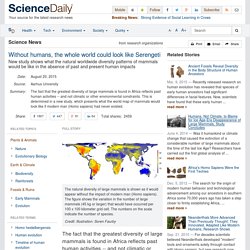
This is determined in a new study, which presents what the world map of mammals would look like if modern man (Homo sapiens) had never existed. In a world without humans, most of northern Europe would probably now be home to not only wolves, Eurasian elk (moose) and bears, but also animals such as elephants and rhinoceroses. This is demonstrated in a new study conducted by researchers from Aarhus University, Denmark.
In a previous analysis, they have shown that the mass extinction of large mammals during the Last Ice Age and in subsequent millennia (the late-Quaternary megafauna extinction) is largely explainable from the expansion of modern man (Homo sapiens) across the world. Rewilding: Movement to restore wilderness areas is growing across Europe - Travel - The Independent. A safari at the Knepp Wildland Project in West Sussex is very much in this vein.

Knepp Castle and its 3,500 acre estate is home to Charles and Issy Burrell and has been in the family for 220 years. Until 15 years ago the couple farmed the land, but the soil was heavy clay and they struggled to make ends meet. Feds allow Shell to drill for oil in Arctic Ocean off Alaska. The federal government on Monday gave Royal Dutch Shell the final permit it needs to drill for oil in the Arctic Ocean off Alaska's northwest coast for the first time in more than two decades.
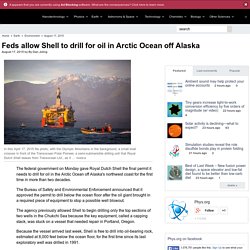
The Bureau of Safety and Environmental Enforcement announced that it approved the permit to drill below the ocean floor after the oil giant brought in a required piece of equipment to stop a possible well blowout. The agency previously allowed Shell to begin drilling only the top sections of two wells in the Chukchi Sea because the key equipment, called a capping stack, was stuck on a vessel that needed repair in Portland, Oregon. Because the vessel arrived last week, Shell is free to drill into oil-bearing rock, estimated at 8,000 feet below the ocean floor, for the first time since its last exploratory well was drilled in 1991.
The Polar Pioneer, a semi-submersible drilling unit that Shell leases from Transocean Ltd., began work July 30 at Shell's Burger J site. New research reveals climate change threat to uplands. Print page Last modified: 31 July 2015 Several rare upland bird species are being put at risk together with other ecosystem functions by the effects of climate change on the UK’s blanket bogs, ecologists at the University of York have discovered.
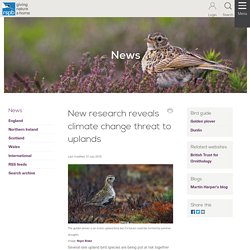
Most of our drinking water comes from these upland peats and several iconic bird species such as the dunlin, golden plover and red grouse depend on these wetland habitats for nesting and feeding. The scientists warn that climate change threatens these habitats, not only from rising temperatures increasing peat decomposition, but also via altered rainfall patterns – with summer droughts drastically affecting the blanket bog hydrology. Los efectos de los retardantes de llama persisten diez años tras los incendios. Paisaje quemado y los equipos de extinción en la zona de Pontevedra. / Contando Estrelas.
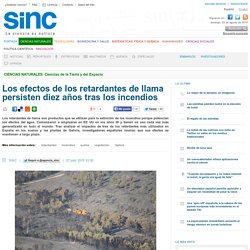
Lion Murderer Walt Palmer Has Done More For Conservation Than You Have. El cangrejo de río ‘autóctono’ español es italiano / Fotografías / Multimedia. La pérdida de hábitat amenaza a los felinos del mundo #naturaleza #conservación #felinos. Only China Can Save the Seas [Commentary] EU wants stiff penalties and wiretaps to fight environmental crime. Technologies and innovations to better understand changes in land use - Global Landscapes Forum. Technology and big data are transforming the way we monitor forests and climate in a post-Kyoto world.

Static studies have given way to a stream of real-time information used by governments, businesses, and communities to better manage forests for conservation, for economic benefit, and for carbon. Several such ground-breaking new remote-sensing data products related to estimating emissions from deforestation around the world will be launched at COP 20 (featured on Global Forest Watch). Oilsands companies not responsible for bird deaths. WWT - Wetlands for life - What's on. North West Bird Watching Festival Whatever the weather, The North West Bird Watching Festival is an enjoyable and informative day out.

Meet 7 new endangered species on the IUCN Red List. Earth's preeminent list of endangered species marks its 50th anniversary this year, but there isn't much time to celebrate. Why natural conservation methods matter for the future of urban water supplies. The liquid that comes cascading out of the faucet each time you step up to the sink to brush your teeth, wash your hands or refill your self-cleaning, basil-growing aquarium has to come from somewhere, you know. And unless the municipal water supply in your city or town has been compromised or you are hyper-aware of personal water usage due to drought, there’s a good chance you might not know where that somewhere is.
In addition to the report itself, Urban Water Blueprint includes a fascinating interactive website that details the state of 2,000 water-supplying ecosystems and the 530 cities across the globe, home to more than 1 billion people, that draw from them. Conservation deal saves world's largest bat colony. With white-nose syndrome sweeping some parts of the country and killing millions of bats, there's rarely any good news to share about these cave-dwelling mammals. But the bats of Bracken Bat Cave have reason to celebrate, thanks to a $20 million deal signed on Halloween to protect these animals from a housing development that would have threatened the world's largest bat colony.
Located outside of San Antonio, the cave is home to the largest colony of Mexican free-tailed bats in the world with 15 million to 20 million bats. Twitter. Albania’s Coastal Wetlands: Killing Field for Migrating Birds by Phil McKenna: Yale Environment 360. 23 Oct 2014: Report by phil mckenna Each spring, hundreds of thousands of migrating waterbirds flock northward from Africa across the Mediterranean and Adriatic Seas. In search of food, they alight briefly on Albania’s Buna Delta — one of the largest remaining wetlands in all of the Balkan Peninsula. The delta is also one of the most notorious killing grounds for migrating birds in all of Europe.
“There is a marsh harrier,” declares Borut Stumberger, a hard-bitten Slovenian researcher and veterinarian, during a recent field census of dwindling bird life in the delta. Sur Twitter : "We've wiped out half the world's wildlife since 1970, by @bradplumer #conservation. WWF: The Earth has lost half its wildlife since 1970. Study: We've wiped out half the world's wildlife since 1970. Monarch Butterflies at the Center of a Continent-Wide Conservation Effort.
The monarch butterfly hits the peak of its winter migration in October, and as it makes its way from Canada and the U.S. to Mexico, all three countries will be watching its numbers closely. In February, President Enrique Peña Nieto of Mexico, flanked by President Barack Obama and Prime Minister Stephen Harper of Canada, announced that they would set up a task force charged with saving the continent's monarchs.
Then in late May, the three countries devoted several sessions to the butterfly at an annual wildlife conservation summit. That is because the monarch is declining precipitously. In the past decade the population east of the Rocky Mountains dropped from an estimated one billion to the 33 million that survived their journey last winter; the western population, which winters in California, has also dwindled in recent years. “Extinct” Snail Found Alive—But for How Long? El cambio climático podría reducir la distribución de los seres vivos tres veces más de lo previsto.
Si se tiene en cuenta la capacidad de adaptación a los cambios ambientales de las diferentes poblaciones de una misma especie, las predicciones ante el cambio climático son más pesimistas. Esta es la principal conclusión de un artículo que investigadores del Museo Nacional de Ciencias Naturales (MNCN-CSIC) han publicado en la revista Ecology letters. Las especies podrían perder entre dos y tres veces más área de distribución por barreras geográficas y humanas.
Medio Ambiente: ¿qué está fallando? La encuesta europea Eurobarómetro publicada hace unos días indica que "la protección del medio ambiente es importante para la mayoría de los europeos". Los datos son contundentes: el 95% de los europeos manifiesta que, efectivamente, la protección del medio es importante para ellos. En el caso de España, los datos superan incluso ese porcentaje. Vultures facing extinction, say experts. U.S. Pacific Blue Whales Seen Rebounding Close To Historic Levels. Off the coast of Southern California, a crowd watches a blue whale rise to the surface earlier this summer. A new study says the population of blue whales off the West Coast is close to historic levels. LUCERNE FESTIVAL > Festivals > LUCERNE FESTIVAL im Sommer > Late Night. ¡Nos invaden! Cinco especies que ponen en peligro la biodiversidad española. La globalización es el mayor peligro para la biodiversidad de ecosistemas autóctonos.
La movilidad y los descuidos del hombre han ocasionado más daño que cualquier técnica transgénica controlada. En España hay más de 1.400 especies invasoras, más de 11.000 en toda Europa. La mayoría se hacen fuertes por su agresividad hasta alterar y transformar el entorno a su medida. Quality of biodiversity, not just quantity, is key: Right mix of species is needed for conservation. Blog SEO/BirdLife » Un siglo sin la paloma migratoria americana. Se cumple hoy exactamente un siglo de la extinción de una de las aves más espectaculares del mundo, la paloma migratoria americana (Ectopistes migratorius), cuyos gigantescos bandos de millones de ejemplares dejaron atónitos a los primeros europeos que recorrieron América del Norte.
Esos mismos hombres las cazaron con tal avidez que consiguieron que no quedara ni una sola. Era tal la abundancia de aquel recurso que lo consideraban inagotable. Com afecta l'expansió del senglar als espais naturals d'alta muntanya? Nomadic plastics. Renowned Biologist E O Wilson: Half the World Should be Set Aside for Animals. Can the World Really Set Aside Half of the Planet for Wildlife? Humedales, los oasis cotidianos. Humedales, los oasis cotidianos. Inter Research » ESR » v25 » n1 » p1-18. AMOUNARBOL : Yo no soy medicina ... Dead Zones: Devil in the Deep Blue Sea. Experiments on Humans Can Save Wildlife.